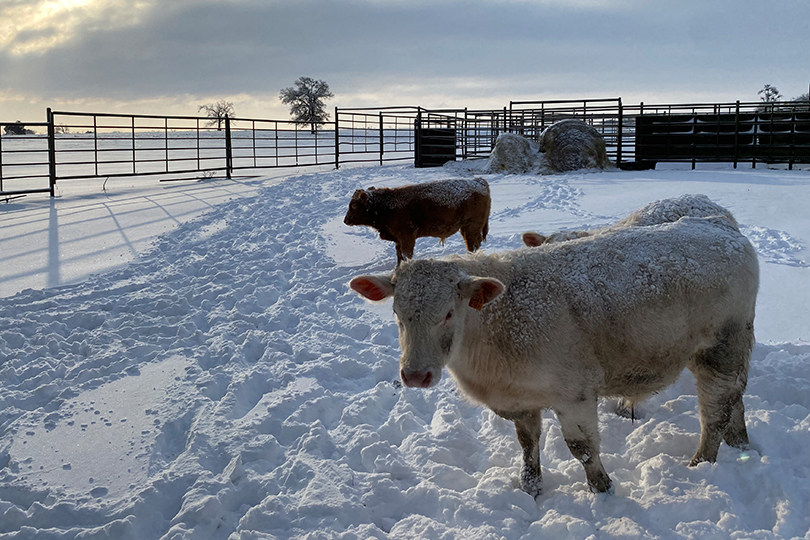Programs and resources are available from the U.S. Department of Agriculture (USDA) for rural communities, farmers and ranchers, families and small businesses affected by the recent winter storms.
USDA staff in the regional, state and county offices are prepared with a variety of program flexibilities and other assistance to residents, farmers, ranchers and impacted communities.
“USDA is committed to getting help to producers and rural Americans impacted by the severe weather in many parts of the country. As severe weather and natural disasters continue to threaten the livelihoods of thousands of our farming families, we want you and your communities to know that USDA stands with you,” said Kevin Shea, acting secretary of agriculture. “Visit farmers.gov or your local USDA Service Center to inquire about assistance.”
Risk management and disaster assistance for agricultural operations:
USDA offers several risk management and disaster assistance options to help farmers and ranchers recover after they are impacted by severe weather, including those impacted by winter storms and extreme cold.
Even before disasters strike, USDA provides tools for farmers to manage their risk through the Federal Crop Insurance Program, a public-private partnership between USDA’s Risk Management Agency and private companies and agents. For crops that do not have crop insurance available, the Noninsured Crop Disaster Assistance Program (NAP) is available through the local Farm Service Agency (FSA). This risk protection includes crop production loss and tree loss for certain crop insurance products. It is recommended that farmers reach out to their crop insurance agent or local FSA office for more information.
Farmers who signed up for Federal Crop Insurance or NAP who suffer losses are asked to report crop damage to their crop insurance agent or local FSA office, respectively, within 72 hours of damage discovery and follow up in writing within 15 days.
Livestock and perennial crop producers often have more limited risk management options available, so there are several disaster programs for them. Key programs include:
- The Livestock Indemnity Program and the Emergency Assistance for Livestock, Honeybee and Farm-raised Fish Program reimburses producers for a portion of the value of livestock, poultry and other animals that were killed or severely injured by a natural disaster or loss of feed.
- The Tree Assistance Program provides cost share assistance to rehabilitate or replant and clean-up damage to orchards and vineyards that kill or damage the tree, vines or shrubs. NAP or Federal Crop Insurance often only covers the crop and not the plant.
It’s critical to keep accurate records to document the losses and illnesses following this devastating cold weather event. Ranchers are advised to document beginning livestock numbers by taking photos or videos of any losses.
Other common documentation options include:
- Purchase records
- Production records
- Vaccination records
- Bank or other loan documents
- Third-party certification
USDA also can provide financial resources through its Environmental Quality Incentives Program to help with immediate needs and long-term support to help recover from natural disasters and conserve water resources. Assistance may also be available for emergency animal mortality disposal from natural disasters and other causes.
FSA also has a variety of loans available, including emergency loans that are triggered by disaster declarations and operating loans that can assist farmers and ranchers with credit needs.
Care for livestock and pets:
USDA’s Animal and Plant Health Inspection Service (APHIS) veterinarians are ready to work alongside partners to conduct on-site assessments to document the needs of affected ranchers. More information about protecting livestock is available on APHIS’ Protecting Livestock During a Disaster page. Information about protecting household pets and service animals can be found on APHIS’ Animal Care Emergency Programs page.
APHIS has additional staff on stand-by to provide support should the situation escalate in severity or the number of affected livestock operations increase. Should it be necessary, APHIS has the expertise to assist with carcass removal and disposal, as well.
APHIS’ Animal Care (AC) program is also prepared to respond. The Animal Care Program oversees the welfare of certain animals that are exhibited to the public, bred for commercial sale and used in medical research. In addition to providing technical assistance to regulated facilities, AC inspectors may be checking affected facilities to assess damage and ensure the welfare of their animals.
Helping individuals recover:
USDA’s Food and Nutrition Service (FNS) works with state, local and nongovernmental organizations to provide emergency nutrition assistance, including food packages and infant formula, to households, shelters and mass feeding sites serving people in need. FNS also provides emergency flexibilities in administering nutrition assistance programs at the request of states and works with local authorities to provide benefits. Emergency nutrition assistance and flexibilities requested by states and approved by FNS are posted to the FNS Disaster Assistance website.
Visit USDA’s disaster resources website to learn more about USDA disaster preparedness and response. For more information on USDA disaster assistance programs, contact your local USDA Service Center.

